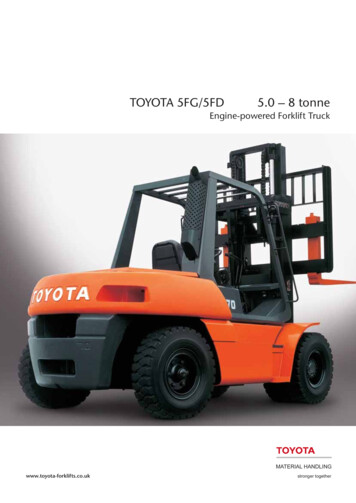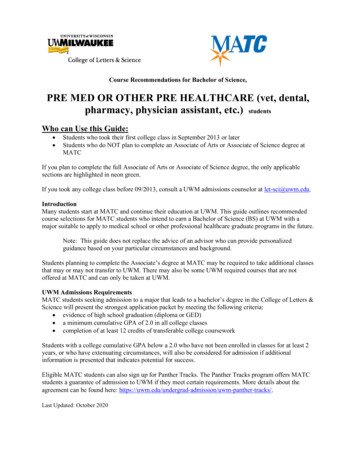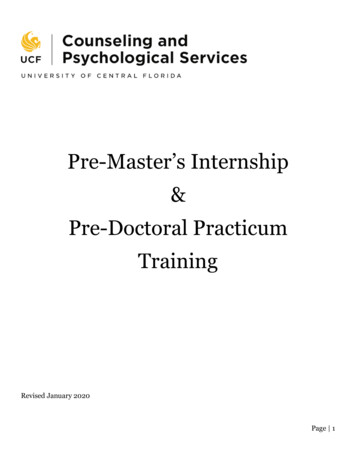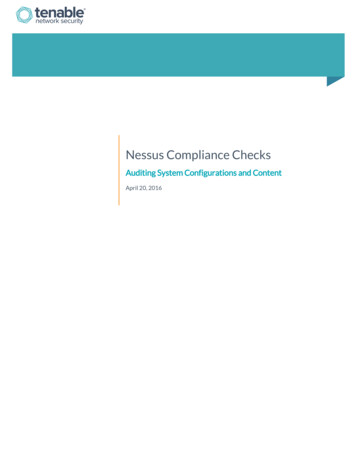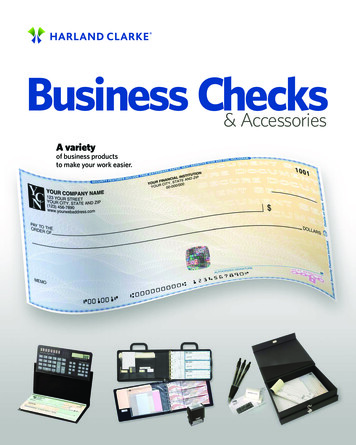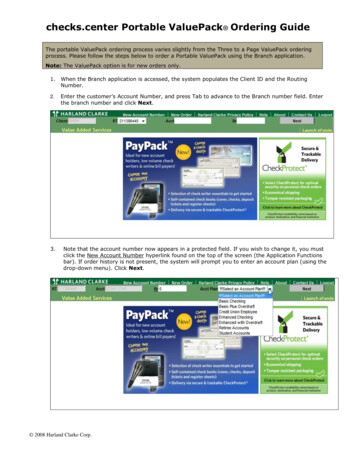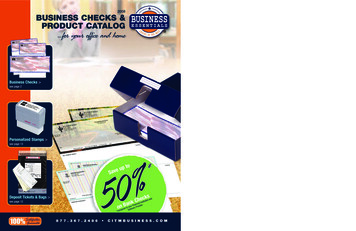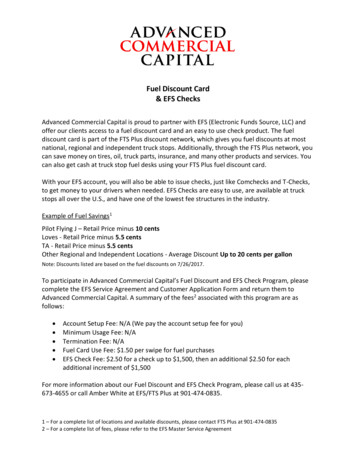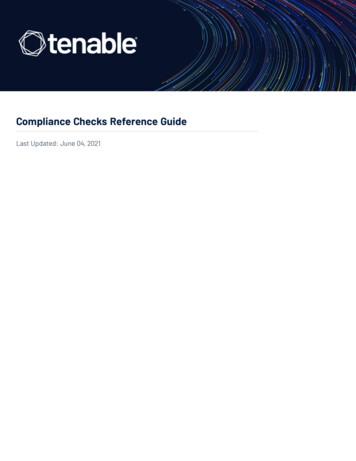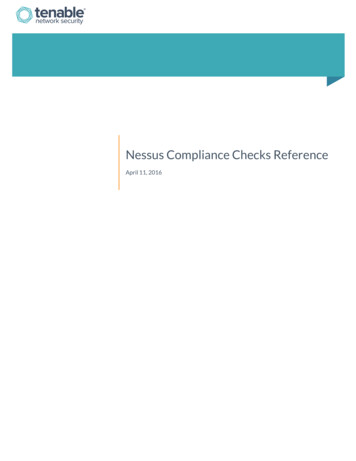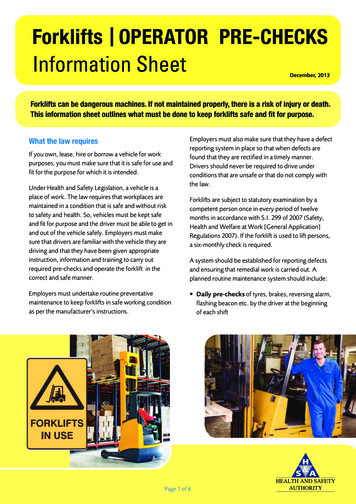
Transcription
Forklifts OPERATOR PRE-CHECKSInformation SheetDecember, 2013Forklifts can be dangerous machines. If not maintained properly, there is a risk of injury or death.This information sheet outlines what must be done to keep forklifts safe and fit for purpose.What the law requiresIf you own, lease, hire or borrow a vehicle for workpurposes, you must make sure that it is safe for use andfit for the purpose for which it is intended.Under Health and Safety Legislation, a vehicle is aplace of work. The law requires that workplaces aremaintained in a condition that is safe and without riskto safety and health. So, vehicles must be kept safeand fit for purpose and the driver must be able to get inand out of the vehicle safely. Employers must makesure that drivers are familiar with the vehicle they aredriving and that they have been given appropriateinstruction, information and training to carry outrequired pre-checks and operate the forklift in thecorrect and safe manner.Employers must undertake routine preventativemaintenance to keep forklifts in safe working conditionas per the manufacturer’s instructions.Employers must also make sure that they have a defectreporting system in place so that when defects arefound that they are rectified in a timely manner.Drivers should never be required to drive underconditions that are unsafe or that do not comply withthe law.Forklifts are subject to statutory examination by acompetent person once in every period of twelvemonths in accordance with S.I. 299 of 2007 (Safety,Health and Welfare at Work [General Application]Regulations 2007). If the forklift is used to lift persons,a six-monthly check is required.A system should be established for reporting defectsand ensuring that remedial work is carried out. Aplanned routine maintenance system should include: Daily pre-checks of tyres, brakes, reversing alarm,flashing beacon etc. by the driver at the beginningof each shiftPage 1 of 6
Forklifts I OPERATOR PRE-CHECKSInformation Sheet In-depth weekly checks by the supervisor/manager; these reports should be written andrecords keptPreventative maintenance Maintenance as per the manufacturer’s instructions Checks by a qualified and competent engineerfollowing any major repair, modification or accidentAll employers and owner-operators should put inplace a forklift preventative maintenance system. Theaim of the system is to identify any forklift defects,damage or problems at an early stage before theybecome a safety issue or a major cost. As well ascausing serious accidents, neglecting to maintain aforklift can result in the breakdown of the machineand unscheduled stoppages to the work process.Daily pre-checksThe majority of faults can be been found and fixed ifthe operator carries out a forklift pre-check beforeuse. The pre-check only takes a few minutes. It makessure that obvious defects that could affect forkliftsafety and the safety of others are identified.Business benefitsThe price of correcting unexpected vehicle failure isalways higher than the cost of preventing that failurein the first place. Well maintained forklifts have bothbusiness and safety benefits. Forklifts that are wellmaintained and regularly checked: Are more reliable Are cheaper to run Have higher residual valueThe direct business benefits are: Less downtime More reliable customer service Longer forklift lifespan and reliabilitySafety benefits include: Improved operator safety Safer operator working environment (workplace) Reduced likelihood of injuries to the operatorand pedestrians in the vicinity of the forkliftForklift pre-checks are a crucial part of thepreventative maintenance system. The operator isoften the first person to notice if there is a problem.Therefore operator pre-checks should beincorporated into daily work routines beforecommencing work with the forklift. It isrecommended that employers prepare their ownforklift checklist to take account of the type and levelof use. Where forklifts are shared by more than onedriver responsibility for conducting checks should beclearly assigned.As a forklift operator, by law, you must make sure thatthe forklift you drive is maintained and used so that itis unlikely to cause a danger to anyone. If specificitems are checked daily, it will help to identify obviousvehicle defects. When conducting pre-checks, it isimportant for the operator to follow a routine so thatnothing is overlooked. When conducting the checks,a high visibility vest or jacket should be worn andcaution should be taken to look out for other vehicles.People being hit or run over by forklifts is one of themain causes of workplace death. Injuries caused byforklifts are generally very serious because of the sizeand weight of the machines.Each operator must be satisfied that their forklift issafe to operate and free from defects. Any defectsshould be recorded and reported to the employer orresponsible person so that appropriate action can betaken. Any safety critical defects must be rectifiedbefore the forklift is used.Page 2 of 6
Forklifts I OPERATOR PRE-CHECKSInformation SheetOperator pre-checkA reliable and documented system of daily or pre-shiftchecks is the cornerstone of good preventativemaintenance. This ensures that essential fluids arekept topped up and potential defects are identifiedbefore they become a problem. Maintenance andchecks should be carried out in accordance with themanufacturer’s instructions. A checklist as per thesample attached can be used to make sure that thedaily/takeover checks are carried out and defectsreported and repaired. It is recommended that theforklift is checked in a clockwise/ anti-clockwisedirection covering the following main visual &operational items: Forks, carriage plate, mast, lift chainare a potentially dangerous and expensive hazard. Isthere any damage to the tyres, such as bulges, cracks,cuts or tears? Are they correctly inflated withappropriate thread depth? Tyres should havesufficient thread and should not be worn to the extentthat the thread indicator contacts the road surface.Check thread depth with a simple gauge. Refer to themanufacturer’s handbook for specific informationabout required thread depth for your forklift tyres. Check the vehicle bodywork for damage. Make surethat body panels are secure and not liable to fall off. Make sure that the number plates (if required) arefitted in the correct position, are clean and that theregistration is clearly visible and appropriately lit. Make sure that all forklift access is in good condition Lights, windscreen and mirrors (if fitted)and is clean and secure, including steps. Check thatthere is nothing present that could cause someone toslip or trip when getting into or out of the forklift.Good housekeeping is essential. Wheels, tyres Energy source (gas, diesel, electric battery) Hydraulics If used on a public road, check that the tax andinsurance discs are in place and in date. Instruments Operator’s compartment; including Seat Belts(Driver Restraint) Carry out pre-checks in a safe area away from passingvehicles and pedestrians. Check that the forklift is sitting square and not leaningto one side. Switch on the hazard lights to show thatthere is someone working and that the lights areworking. Check that the driver’s mirrors are clean,secure and not damaged. Make sure that the seat and steering wheel are set forcomfort, posture and safety and that all controls canbe easily reached. Check your driving lights. Check that the wheels are in good condition with nocracks or damage and that they are secure. The tyres are the only parts of a forklift that are alwaysin contact with the ground. They provide grip formovement, friction for braking and suspension forsafety and comfort. The correct tyres in goodcondition are an essential aid to safe and efficientoperations. The wrong tyres for the application ortyres that are in poor condition or excessively worn,Page 3 of 6
Forklifts I OPERATOR PRE-CHECKSInformation Sheet Forklifts have chains, hydraulic cylinders, valves andseals, all of which are vulnerable to the ingress of dirtof any description. This dirt may cause suchcomponents to deteriorate and fail prematurely.Premature failure leads to disruptive unscheduledmaintenance and extra cost. In addition, forklifts thatoperate with or around chemicals and corrosivematerials will be exposed to possible damage tothese components as well as the chassis, bodywork,cab etc.Further informationFurther information and guidance on forklifts can befound in the HSA's 'Code of Practice for RiderOperated Forklifts: Operator Training andSupplementary Guidance'.Examples of the forklift checks poster and checklistare attached on following pages. Check that there is good all round visibility. Forexample, is vision obstructed by any stickers orpendants? Check that the cab interior is clean andthat there are no loose items which could cause injuryif to the need brake in an emergency arose. Do thelights, horn and warning systems all operatecorrectly? Check that all instruments, gauges and warningdevices are operating correctly and following theircorrect sequence. If any warning lights remain onafter start-up, report them; don’t ignore them. Before driving the vehicle, check that the steeringand brakes are working correctly.Recording of defectsRecord and report any defects in accordance with theemployer’s defect reporting systems. Remember:any safety-critical items must be repaired or theforklift must be taken out of service. Records of allchecks, repairs and services should be kept for theforklift. Analysis of the records may highlight apattern or history of recurring defects or poormaintenance repair standards.Page 4 of 6
Page 5 of 6 No evidence of leaks. No obstructions (overhead or in workingarea). Correct forklift type for workingenvironment.Working Environment Forklift truck registered andnumber plate (front and rear)displayed, clean and legible. Valid tax and insurance discdisplayed. Road lights (side, head, rear, stopand number plate lights) in place,clean, correct colour and workingcorrectly.If used on the Public RoadNote: Head, stop and directionindicator lights are not required ifthe truck cannot exceed 12 milesper hour (19 Kilometres per hour)provided that the driver is clearlyvisible on all sides, can give handsignals to other traffic and thevehicle is not used during lightingup hours except in an adequatelylit public place. Thorough examination carriedout every 12 months (every 6months if used to lift persons)by a competent person andtest certificate available.Thorough Examination General Condition. Forks. Carriage Plate. Mast. Back Rest Extension / Load Guard. Lift Chains. Tyres. Wheels. Overhead Guard / Roll OverProtection Frame. Energy Source. Hydraulics. Identification / Rating Plate. Operator’s Compartment. Access. Lights, Windscreen and Mirrors (if fitted). Fire Extinguisher (if fitted).Seat.Safety Belt.Ignition and Electrical Systems.Reversing Alarm and Horn.Warning Lights and Lights (iffitted).Hydraulic Controls.Brakes (Foot & Parking).Clutch and Gearshift.Steering.Exhaust.Noise.Practical / Operational Checkswww.hsa.ieVisual ChecksForklift Truck Operator Pre-Use Checks
Forklift Truck OperatorPre-Use Checkswww.hsa.ieVehicle Serial / Identification Number OK DEFECTVisual Checks1 General: Good condition with no damage, excessive dirt or rust. Any defects previously noted repaired.2 Forks: Correctly positioned, not damaged, cracked, bent or worn. Anchor pins secure and not worn, loose or bent.3 Carriage Plate: No damage or distortion, sitting square to the mast and lubricated. End stop bolts engaged and secure.4 Mast: No damage, distortion or cracks. No undue wear, scoring, dirt or foreign bodies in channels. End stops secure. Rollers, no unevenwear or incorrect tracking. Slides intact and secure.5 Back Rest Extension / Load Guard: In good condition, secure with no distortion or cracks.6 Lift Chains: Not damaged worn or stretched, no broken links or rust. All pins in place.7 Tyres: No damage, excessive dirt or wear, rust, cracks, splits or separation of tyres and rims. Pneumatic tyres correct air pressure.8 Wheels: Undamaged and free from obstruction and debris. All nuts secure and in place.9 Overhead Guard / Roll Over Protection Frame: Secure, undamaged with no loose items.10 Energy Source: Gas or Diesel: Engine oil, fuel and radiator water level correct. Gas bottle secured, no rust, corrosion or damaged pipes, hoses or seals. Electric: Electrolyte level, battery plug and connections correct. Power cable intact, connected and secure. No exposed wires, batterybrackets secure and battery adequately charged.11 Hydraulics: No damage or fluid leaks, no splits in hoses, no leaks around fittings.Check Items12 Identification / Rating Plate: Intact, clean and legible.13 Operator’s Compartment: Clean with no loose items.14 Access: Steps and grab handles in good condition and clean.15 Lights, Windscreen and Mirrors (if fitted): Clean and undamaged.16 Fire Extinguisher (if fitted): Secure and charged.Operational Checks17 Seat: Good condition, secure and adjusted correctly.18 Safety Belt: Accessible, in good condition and working correctly.19 Ignition & Electrical System: Working correctly. All gauges and instruments visible and working.20 Reversing Alarm and Horn: Working correctly and audible.21 Warning Lights & Lights (if fitted): Working correctly.22 Hydraulic Controls: Working smoothly and correctly.23 Brakes (Foot & Parking): Working correctly.24 Clutch & Gearshift: Working smoothly and correctly.25 Steering: Working correctly with no excessive play.26 Exhaust: No excessive smoke, sparks or flames.Defect DetailsOperator’s SignatureDateManager’s / Supervisor’s SignatureDateNote: This is a sample operator pre-use forklift truck checklist. It is recommended that employers prepare their own operator pre-use checklists, taking account of the manufacturer’srecom
† Longer forklift lifespan and reliability Safety benefits include: † Improved operator safety † Safer operator working environment (workplace) † Reduced likelihood of injuries to the operator and pedestrians in the vicinity of the forklift Preventative maintenance All employers and owner-operators should put in place a forklift preventative maintenance system. The aim of the system is .
